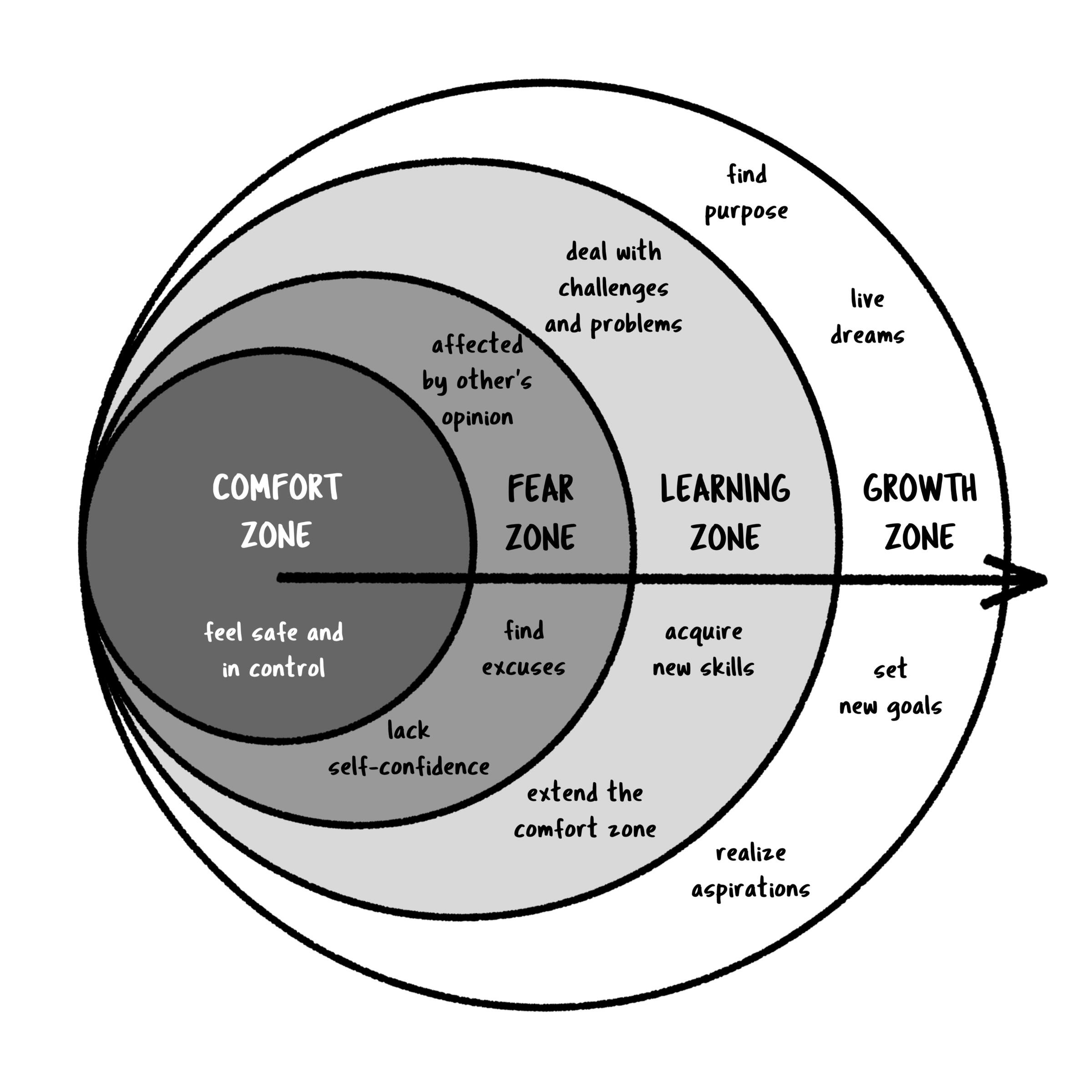
What Does It Mean to Overcome Fear?
Overcoming fear doesn't mean eliminating it—fear is a natural, often helpful emotion that keeps us safe. Instead, it means developing the tools and mindset to act despite fear when growth requires it. Your comfort zone is the psychological space where you feel safe and in control. Stepping outside it means:
- Taking calculated risks despite uncertainty
- Facing situations that trigger anxiety or discomfort
- Choosing growth over safety when appropriate
- Building resilience through progressive challenges
The History and Science Behind Fear
Fear is one of our oldest survival mechanisms, originating in the amygdala—our brain's alarm system. While this served our ancestors well when facing predators, modern fears are often about social rejection, failure, or uncertainty—threats to our ego rather than our existence. Research by neuroscientist Joseph LeDoux shows that fear responses can be rewired through repeated exposure and positive experiences. The concept of systematically stepping outside one's comfort zone was popularized by psychologist Abraham Maslow and further developed through cognitive behavioral therapy techniques.
How to Overcome Fear: Step by Step
Step 1: Identify and Name Your Fears
Specificity reduces fear's power. Instead of "I'm afraid of failure," identify exactly what you fear: "I'm afraid of losing my investment," or "I'm afraid people will judge me."
Write down:
- What exactly am I afraid of?
- What's the worst-case scenario?
- How likely is this scenario?
- Could I recover if it happened?
Step 2: Understand Your Comfort Zone Map
Draw three concentric circles:
- Comfort Zone: Activities that feel safe and easy
- Stretch Zone: Activities that feel challenging but manageable
- Panic Zone: Activities that trigger overwhelming fear
Your growth happens in the stretch zone.
Step 3: Start with Micro-Courage
Build your fear-conquering muscle with small acts of courage:
- Speak up in a meeting
- Try a new restaurant alone
- Take a different route to work
- Start a conversation with a stranger
Step 4: Use the 5-Second Rule
When you feel the impulse to act but fear holds you back, count backwards: 5-4-3-2-1, then move. This interrupts the fear response and engages your prefrontal cortex.
Step 5: Reframe Fear as Excitement
Fear and excitement create identical physiological responses. Tell yourself "I'm excited" instead of "I'm scared"—research shows this simple reframe improves performance.
Step 6: Create Fear Ladders
Break big fears into smaller steps:
- Fear: Public speaking
- Step 1: Speak up in small group
- Step 2: Give toast at dinner party
- Step 3: Present to team at work
- Step 4: Speak at local meetup
- Step 5: Give conference presentation
Step 7: Celebrate Courage, Not Just Outcomes
Reward yourself for taking action regardless of results. The act of facing fear is the victory.
Practical Examples
Example 1: Career Change Fear Ladder
Fear: Leaving stable job for dream career
Progressive Steps:
- Research the new field for 30 minutes daily
- Attend one industry networking event
- Take an online course in the new field
- Start a side project while employed
- Connect with 5 professionals in target field
- Apply for one job in new field
- Negotiate transition plan with current employer
Example 2: Social Anxiety Breakthrough
Fear: Social rejection at events
Progressive Steps:
- Attend event and stay for 15 minutes
- Make eye contact and smile at 5 people
- Introduce yourself to 1 person
- Have a 5-minute conversation
- Exchange contact information
- Suggest meeting for coffee
- Host your own small gathering
Example 3: Entrepreneurial Leap
Fear: Starting a business and failing
Progressive Steps:
- Validate idea with 10 potential customers
- Create minimal viable product
- Make first sale to friend/family
- Launch to small beta group
- Invest $500 in marketing
- Quit job when revenue hits 50% of salary
- Scale to full business operations
Benefits and Life Improvements
Expanded Possibilities
Each time you step outside your comfort zone, it expands. What once terrified you becomes normal, opening doors you couldn't even see before.
Increased Confidence
Confidence isn't the absence of fear—it's the memory of overcoming it. Each conquered fear builds unshakeable self-trust.
Accelerated Growth
All growth happens outside your comfort zone. The more you practice discomfort, the faster you evolve personally and professionally.
Reduced Anxiety
Paradoxically, regularly facing fears reduces overall anxiety. You prove to yourself that you can handle discomfort.
Better Decision Making
When fear doesn't control you, decisions are based on opportunity rather than avoidance. You choose based on potential gain, not potential loss.
Richer Life Experiences
A life lived in the comfort zone is a life half-lived. Overcoming fear leads to adventures, relationships, and achievements that define a life well-lived.
Inspiring Others
Your courage gives others permission to be brave. By facing your fears, you become a model for those around you.
Resilience and Adaptability
Regular comfort zone expansion builds psychological resilience. You become someone who thrives on change rather than fears it.
Transform Fear Into Fuel
Fear will never disappear—nor should it. The goal isn't fearlessness but fear mastery. Every time you feel that familiar flutter of anxiety about trying something new, recognize it as a signal: growth is available here. The question isn't "How do I stop feeling afraid?" but "What would I do if I were brave?"
Start today. Choose one small action outside your comfort zone. Feel the fear, acknowledge it, then act anyway. Each small act of courage rewrites your relationship with fear, transforming it from a wall that confines you into a compass that points toward your potential. Your extraordinary life isn't waiting on the other side of fear—it begins the moment you take the first step despite it.